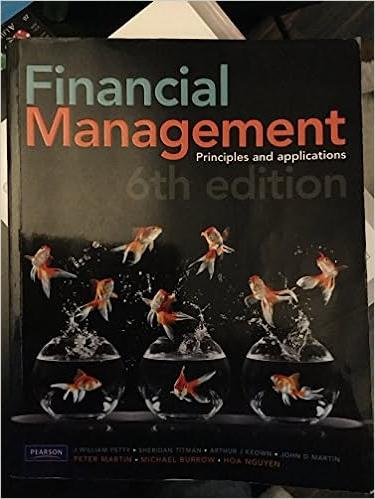Answered step by step
Verified Expert Solution
Question
1 Approved Answer
Question 1 How is taxation different in the corporate and proprietorship forms of business? Explain double taxation. Question 2 What is leverage and how does
Question
How is taxation different in the corporate and proprietorship forms of business? Explain double taxation.
Question
What is leverage and how does it work? What is the main concern about using it
Question
Sweet Tooth Cookies, Inc. has the following ratios
ROE
TA turnover
ROS
What percentage of its assets are financed by equity? Hint: Substitute into the Extended DuPont Equation.
Question
A financial plan has to be either a prediction about the future or a statement of goals; it can't be both. Explain this statement and comment on its validity.
Question
NuMode Fashions Inc. manufactures quality womens wear, and needs to borrow money to get through a brief cash shortage. Unfortunately, sales are down, and lenders consider the firm risky. The CFO has asked you to estimate the interest rate NuMode should expect to pay on a one year loan. Shes told you to assume a default risk premium even though the loan is relatively short, and to assume the liquidity and maturity risk premiums are each Inflation is expected to be over the next twelve months. Economists believe the pure interest rate is currently about
Question
How much is a guaranteed promise of $ to be received in years worth today if interest is
Question
A bond that pays interest compounded annually on a $ face value will mature in years. The interest rate is now What should the bonds market price be
Question
Blackstone Corporation's $ preferred was issued five years ago. The riskappropriate interest rate for the issue is currently What is this preferred stock selling for today?
Question
Conestoga Ltd has the following estimated probability distribution of returns.
Return Probability
Calculate Conestogas expected return, the variance and standard deviation of its expected return and the returns coefficient of variation.
Question
Gander, Inc. is considering two projects with the following cash flows.
Year Project X Project Y
$$
Gander uses the payback period method of capital budgeting and accepts only projects with payback periods of years or less.
a If the projects are presented as standalone opportunities which ones would
Gander accept? If they were mutually exclusive and Gander disregarded its
three year rule, which project would be chosen?
b Is there a flaw in the thinking behind the correct answers to part a
Step by Step Solution
There are 3 Steps involved in it
Step: 1

Get Instant Access to Expert-Tailored Solutions
See step-by-step solutions with expert insights and AI powered tools for academic success
Step: 2

Step: 3

Ace Your Homework with AI
Get the answers you need in no time with our AI-driven, step-by-step assistance
Get Started


